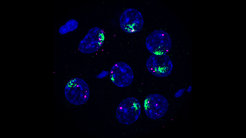Equality in gene expression
Genetic screen reveals new factor driving X-chromosome inactivation during development.
Transcription factors called GATA activate the expression of RNA molecules that repress one of the two X chromosomes during the development of female mice. These are the results of a new study by the lab of Edda Schulz, that has just been published in Nature Cell Biology.

Female mammals carry two X chromosomes, which can lead to a potentially dangerous double expression of genes. The extra dose of gene expression is lethal in the developing embryo, and double gene expression has been found in certain cancers in the adult organism. To prevent damage, mechanisms are in place to silence the additional X chromosome and balance gene activity. Cells express so called Xist RNA (X inactive specific transcript), which silences genes across the chromosome. In the developing mouse embryo, Xist is rapidly upregulated very early from the paternal X chromosome, a process known as imprinted X-inactivation. "The idea was that Xist is active by default and only repressed in certain cell types where it is supposed be silent," says group leader Edda Schulz. "Our data now show that there are cell type-specific factors that are necessary to drive Xist expression and that Xist requires active mechanisms to be expressed."
Originally, the scientists studied random X-inactivation, a later process, in which each cell randomly silences one X chromosome. Led by first author Liat Ravid Lustig, the team performed a genetic screen looking for factors encoded by the X chromosome that could help female cells to regulate Xist at this stage. Using Cas9 gene-editing, they overexpressed gene after gene to identify those that had an effect on Xist activation. "We were quite surprised to see that one of the strongest activators discovered in this screen was a family of transcription factors called GATA. These factors are not expressed in cells that initiate random X-inactivation and could not explain the phenomenon we were initially interested in," explains Edda Schulz. The scientists therefore turned their attention to imprinted X-inactivation. They teamed up with Alexander Meissner's lab, which has experience in studying early development in mouse embryos. In a series of experiments, the scientists showed that these factors that bind the gene sequence GATA (for the nucleobases Guanin, Adenin and Thymidin) regulate Xist in pre-implantation embryos.
GATA factors were known to be involved in determining cell identity, but a link to X-inactivation had not been established. "We can now show that X-inactivation is directly linked to the mechanisms that generate different cell types," says Edda Schulz. Although imprinted X-inactivation is specific to rodents, both Xist and GATA factors have been shown to be active in human embryos shortly after fertilization. The knowledge gained from model organisms may eventually help to better understand how Xist is controlled in humans and other species.












